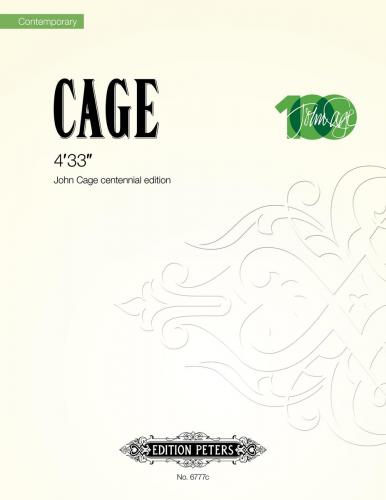
C. F. PETERS - 100400
Cage 4'33'' Centennial Edition
Composer: John Cage
Publisher: Edition Peters
Instrumentation: Piano
Cage 4'33'' Centennial Edition
Juilliard Store
144 West 66th Street
New York NY 10023
United States
Choose options
Cage 4'33'' Centennial Edition
Juilliard Store
144 West 66th Street
New York NY 10023
United States
Cage 4'33'' Centennial Edition
Juilliard Store
144 West 66th Street
New York NY 10023
United States
4’33” is a three-movement composition in which the performer makes no intentional sounds for the duration of the piece: four minutes and thirty three seconds. It was premiered in 1952, and has been generating controversy and debate ever since. The premiere of 4'33" was given by David Tudor on August 29th, 1952, at Maverick Concert Hall, Woodstock, New York as part of a recital of contemporary piano music. The audience saw him sit at the piano and, to mark the beginning of the piece, close the keyboard lid. Some time later he opened it briefly, to mark the end of the first movement. This process was repeated for the second and third movements. The piece passed without a note being played - in fact, without Tudor (or anyone else) having made any deliberate sound as part of the piece. Tudor timed the three movements with a stopwatch, while turning the pages of the score.
Cage later spoke regarding the premiere and the audience’s reaction: “They missed the point. There’s no such thing as silence. What they thought was silence, because they didn’t know how to listen, was full of accidental sounds. You could hear the wind stirring outside during the first movement. During the second, raindrops began pattering the roof, and during the third, people themselves made all kinds of interesting sounds as they talked or walked out.”
"This edition of 4'33" -- one of John Cage's most influential compositions -- is published in honor of the centennial of the composer's birth. It includes two of the extant versions: the 1952 proportional notation version (please see edition EP6777a) and the 1986 calligraphic "tacet" version (please see edition EP6777). An earlier typed edition of the "tacet" version, essentially the same as the calligraphic version, is also included as a frontispiece. This typed "tacet" version was used by C. F. Peters as the published edition from 1960, when Cage came to Peters, until 1986, when Cage created the calligraphic "tacet" version.
The manuscript of 4'33" used by David Tudor for the premiere on August 29th, 1952 at Maverick Concert Hall in Woodstock, New York, is lost. This version used an entirely different notation system. Cage said it was composed " ... just like MUSIC OF CHANGES. That's how I knew how long it was when I added up the notes. It was done like a piece of music, except there were no sounds -- but there were durations." David Tudor reconstructed the manuscript in 1989. We have included his reconstruction in this volume, although it has been reduced to fit our format (the original was 9.3 x 12.5 inches). This reduction renders Tudor's durational marking "60 quarter notes = 2-1/2 cm." moot. We are grateful to the Getty Research Institute, Nancy Perloff, and Virginia Mokslaveskas for helping to make the publication of this reconstruction possible.
The final item in this collection is the text of a letter from John Cage to Helen Wolff, Christian Wolff's mother*. It was written in 1954, and concerns an imminent performance of 4'33" by David Tudor. Cage is responding to a letter from Mrs Wolff and seeks to explain the piece." (Gene Caprioglio - Vice-President, C. F. Peters Corporation)
* Helen Wolff, in addition to having been the mother of Christian Wolff, was an editor and publisher, regarded by her colleagues in the international book world as the grande dame of letters. She and her husband founded Pantheon Books in 1942, and went on to publish works that included Boris Pasternak's Doctor Zhivago. In 1961, they left Pantheon to establish the imprint "A Helen and Kurt Wolff Book" at Harcourt Brace Jovanovich, and were particularly respected for bringing out translations of distinguished European authors. They were successful in acquiring important foreign books on account of Mrs Wolff's fluency in several languages (growing up in Macedonia, she, her sister, and their parents spoke German, Turkish, and Serbian). Among the authors with whom Mrs Wolff worked closely were Günter Grass, Umberto Eco, Max Frisch, Georges Simenon, Stanislaw Lem, and Amos Oz.
